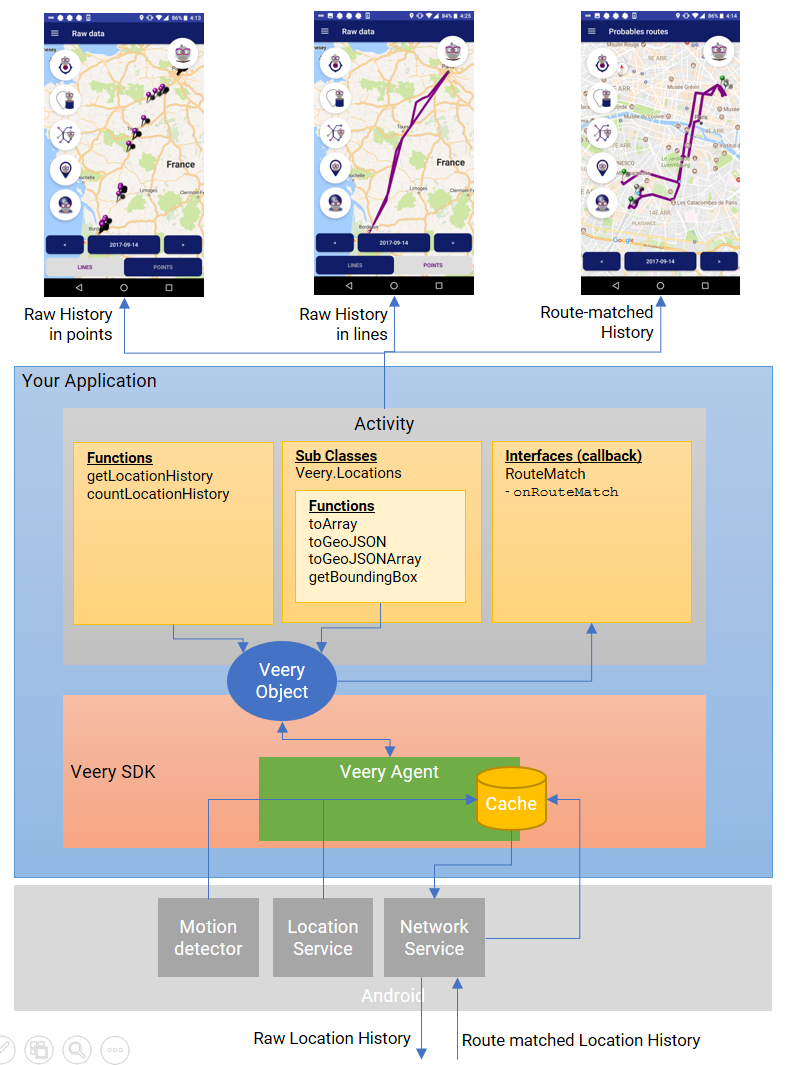Location history
This section describes how to get the Location history collected by the Veery agent (Android native).

Depending on how Veery was activated (Veery.ROUTE_MATCH), Veery collects the geolocations and store them into the Cache.
The history of observe geolocation can be extracted from the Cache using the Location History functions.
Veery offers three types of History :
- Raw data in points : the set of points as they were seen by the captors.
- Raw data in lines : the set of points as they were seen by the captors, but linked together as a MultiLineString GeoJson Object.
- Route Matched : These are historical data that have been completed by the Veery Backend and the Veery Geoprofiling algorithms. The Veery Backend will transform the Raw data points to "probable roads" considering times and speeds. At the most advanced version of the Route Matching, it uses the whole history of the user, detecting similar days and similar trips, using traffic jams and train timetables to find out what is the most probable road that the user is used to use. At the end it decides which probable road has the best fit with the raw data observed for each trip. In short : it fills the holes left by the low consuming trackings.
So, the level of Location History you can receive from the Veery agent depends on how Veery was activated :
| Veery activate mode | Raw in points | Raw in Lines | Simple route match | User geoprofile route-match |
|---|---|---|---|---|
| Veery.DEACTIVATE_ALL | ||||
| Veery.FOREGROUND | X (only "app active") | X (only "app active") | ||
| Veery.BACKGROUND | X | X | ||
| Veery.BACKEND | X | X | X | |
| Veery.GEOPROFILE | X | X | X |
Veery Functions
getLocationHistory
Get Historical data of Geolocations observed during a given period of time.
Historical data can be requested in RAW or in ROUTEMATCH level.
countLocationHistory
Count Historical data of Geolocations observed during a given period of time.
Historical data can be requested in RAW or in ROUTEMATCH level.
- ROUTEMATCH will returns the number of trips computed.
- RAW will returns the number of positions observed.
requestRouteMatch
Request for a callback event when a new trip is routematched by the Veery Backend.
Veery sub-classes
Veery.Locations
Subclass of Veery reprsenting a set of geolocations previsouly recorded.
toArray
Return an array of Location object.
Locations.toGeoJSON
Return a GeoJSON containing the set of locations (Point or MultiLineString).
All the locations will be in the same GeoJson object.
toGeoJSONArray
Return an array of GeoJSON.
Each GeoJson containing either a single trip or a single Point.
getBoundingBox
Get the bounding box which envelopes all locations in the set.
Veery Interfaces
RouteMatch
Route match interface could be passed as parameter to the requestRouteMatch function
onRouteMatch
Callback triggered every time a trip is computed by the Veery backend.